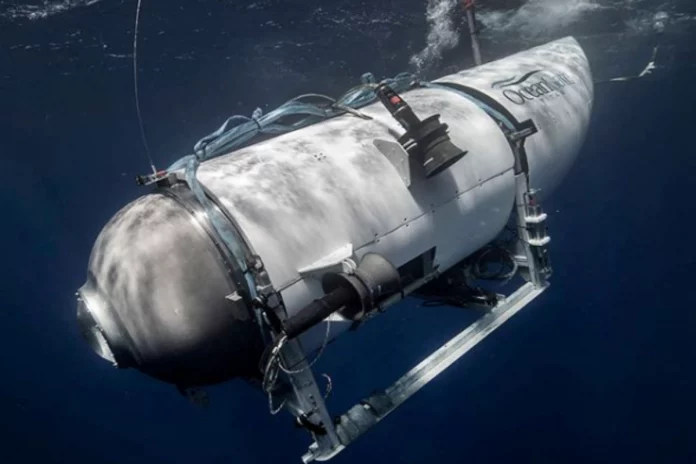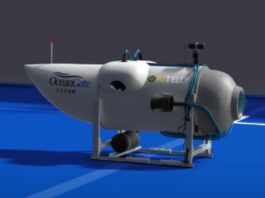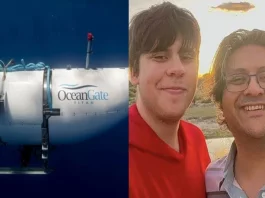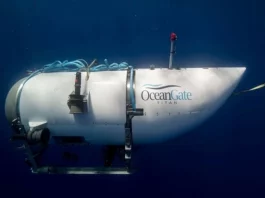Titan submersible: On Wednesday (local time), rescuers sent more ships and vessels to the region where a submersible vanished while travelling to the Titanic debris site in the hopes that underwater sounds they had heard for the second day in a row may help focus their increasingly desperate search.
Authorities Remain Hopeful as Search and Rescue Teams Tackle Vast Underwater Area
According to Captain Jamie Frederick of the First Coast Guard District, search and rescue teams are combing an area twice the size of Connecticut in waters that are 2.5 miles deep. He said that authorities are still holding out hope that the Titan’s five passengers will survive. “This is a search and rescue mission, 100%,” he declared. We’ll keep using all of the resources at our disposal to try to locate the Titan and the crew. Even those who voiced confidence, however, cautioned that there are still many challenges ahead, including locating the ship, getting to it with rescue tools, and raising it to the surface, presuming it is still in good condition. And before that happens, the oxygen supply for the passengers must run out, which some have said might occur as early as Thursday morning.
Safety Issues and Harsh Conditions Complicate Submersible Search
Meanwhile, according to recently discovered claims, the submersible’s development process included substantial cautions concerning vessel safety. According to oceanographer Donald Murphy, who served as the International Ice Patrol’s chief scientist, the region of the North Atlantic where the Titan vanished on Sunday is prone to fog and stormy weather, making it a very difficult environment to conduct a search-and-rescue mission. The missing submarine may be as deep as 3,800 metres (12,500 ft) below the surface, not far from the Titanic’s watery grave. Remotely controlled robots with cameras are essential to the search because they can examine the seafloor in real time at depths that other vessels can’t. On Wednesday, two were in operation nearby, and more were on the way, according to officials.
A Ray of Hope Amidst Uncertainty
The precise location and source of the sounds haven’t yet been identified, according to Frederick, who noted that they did offer a chance to focus the search. To be honest, he continued, “We have no idea what these are. The sounds have been described as “banging noises,” according to retired Navy Captain Carl Hartsfield, who is currently the director of the Woods Hole Oceanographic Systems Laboratory. However, he cautioned that search teams “have to put the whole picture together in context and they have to eliminate potential manmade sources other than the Titan.” Some analysts found the claim to be optimistic because submarine crews are instructed to hammer on their submersibles’ hulls in order to be picked up by sonar when they are unable to communicate with the surface. A sophisticated naval salvage equipment that might be used to pull the Titan to the surface has arrived in St. John’s, Canada, a US Navy official said during a media briefing on Wednesday. However, it will take another 24 hours to get it ready for deployment. The apparatus can lift “large, bulky and heavy undersea objects such as aircraft or small vessels,” according to a statement from the Navy.
Must Read: Search for Titan Submersible intensified as Sonar detects ‘Banging sounds’
Unveiling Key Facts About the Titan Submersible
The Titan weighs 9,071 kilogrammes (20,000 pounds). Up to 60,000 pounds (27,216 kilogrammes) can be lifted by the Navy’s Flyaway Deep Ocean Salvage System. The submersible has seven back-up devices, including an inflatable balloon, drop-off lead pipes, and sandbags, to get back to the surface. The CEO of the corporation leading the expedition, pilot Stockton Rush, is missing aboard the ship. A British explorer, two members of a Pakistani business family, and a Titanic expert are among his passengers. Authorities launched a search in waters about 435 miles (700 km) south of St. John’s after receiving a word that the 22-foot carbon-fiber yacht was overdue on Sunday night. According to David Concannon, an advisor to OceanGate Expeditions, which handled the project, the submersible had a four-day oxygen supply when it was sent to sea around 6 am on Sunday (June 17). According to documents the corporation sent to a US District Court in Norfolk, Virginia, which is in charge of handling cases surrounding the Titanic catastrophe, at least 46 persons successfully travelled aboard OceanGate’s submersible to the Titanic wreck site in 2021 and 2022. Documents, however, reveal that OceanGate had been informed that the method the experimental vessel was created could pose catastrophic safety issues.
Scrutinizing Issues Surrounding the Titan Expedition
In a letter to Rush, OceanGate’s CEO, that same year, the Marine Technology Society, which promotes itself as “a professional group of ocean engineers, technologists, policy-makers, and educators,” also voiced its worry. The society argued that in order to protect passengers, the business must submit its prototype to testing monitored by an industry professional before going live. Those materials were initially covered by The New York Times.Chris Brown, a British explorer who made a deposit but then backed out of the Titan expedition due to what he called safety concerns, has challenged the Titan’s use of a basic, readily accessible video game controller.However, OceanGate claims that because they have proven to be dependable, many of the ship’s parts are off-the-shelf. Pakistani citizens Shahzada Dawood and his son Suleman, whose eponymous company makes investments all around the country, are also on board. Employees at his companies in Pakistan’s port city of Karachi claimed to have prayed for the two’s safe return, as had government representatives. Paul-Henry Nargeolet, a French adventurer and Titanic authority, was also travelling with the ship. The disappearance of the submersible highlights the risks associated with operating in deep water and the recreational exploration of the sea and space, according to retired Navy Vice Admiral Robert Murrett, who is now the deputy director of the Institute for Security Policy and Law at Syracuse University. “Two environments where in recent past we’ve seen people operate in hazardous, potentially lethal environments,” Murrett said.
Keep watching our YouTube Channel ‘DNP INDIA’. Also, please subscribe and follow us on FACEBOOK, INSTAGRAM, and TWITTER




